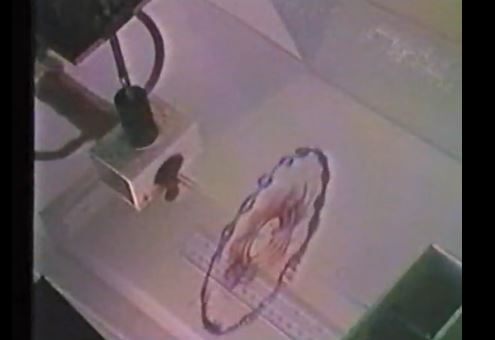Accepting an absolute statement like this would take most of the fun out of the thread! 🙁Nothing goes faster than light. 🙄
My bet is that most participants would prefer to speculate.
If it's good enough for astrophysicists, it's good enough for the rest of us! 😛
The way I understand it is the photon behaves like a probability function (wave) until it is detected (ie interacts with another particle), at which point it behaves as a particle. I think you showed a few weeks ago a graphic where it spoke about the wave function collapsing (attrib. To Schroedinger) upon detection.
I’ll make a sketch tomorrow.
I’ll make a sketch tomorrow.
The wave function is not a wave, but an equation derived from the Schrodinger equation. It describes the evolving probabilities of where we would find the photon were it to be detected.The way I understand it is the photon behaves like a probability function (wave) until it is detected...
In the double slit experiment there is a superposition of probabilities. The wave function might tell us that at any one instant there is a 20% probability that the photon will be detected at this location on the screen, a 40% probability that it will be detected in that location, and so on.
The collapse of the wave function is the transformation from a superposition of different probabilities into a 100% probability i.e. into a localised particle.
Going back to your serious question, it would appear that when the wave function collapses, all probabilities except one instantaneously become 0%. However, 'instantaneously' would indicate faster than light, which would violate the well confirmed special theory of relativity.
This was a problem pointed out by Einstein and his colleagues in 'The EPR Paper'. Nonlocality and Entanglement - Quantum Theory and the Uncertainty Principle - The Physics of the Universe
However, experiments on entanglement have shown that the quantum world is not bound by the principle of locality.
Nothing goes faster than light. 🙄
... That we know of.
There, I fixed it! No need to bring fiction into this Galu 😀
@Galu, I imagine if time does not existing for a photon, then they are not separated either by time or by distance from other photons that they are entangled with.
The wave function can be understood intuitively by imagining it as a bubble - you can prick it anywhere and it collapses - so all probabilities are covered within the bubble envelope (I think we touched on this a few weeks ago 🙂 )
The way I understand it, it was Born the re-interpreted Schrödinger's wave function as a probability density function and that turned out to be the more accurate description of what was going on.
Back to my original post. Lets replace photon 'wave front' with probability density. If you interact with the photon that has a probability of existing over a huge area, it still ceases to exist once it interacts with an atom
The wave function can be understood intuitively by imagining it as a bubble - you can prick it anywhere and it collapses - so all probabilities are covered within the bubble envelope (I think we touched on this a few weeks ago 🙂 )
The way I understand it, it was Born the re-interpreted Schrödinger's wave function as a probability density function and that turned out to be the more accurate description of what was going on.
Back to my original post. Lets replace photon 'wave front' with probability density. If you interact with the photon that has a probability of existing over a huge area, it still ceases to exist once it interacts with an atom
I'm still wrestling with your original post, regardless of whether you replace 'wavefront' with 'probability density', or even a 'bubble'.If a photon emitted from an object very distant is intercepted, it ceases to exist everywhere despite the fact that the photon ‘wavefront’ may be many light years across.

The question remains: Does the energy of a photon spread out as a light wave in space, then somehow collect itself at one point, moving faster than light to do so?
Nobody appears to have given an answer to this question, not even Richard Feynman who regarded the collapse of the probabilities into one specific state as the one great mystery in quantum mechanics.
"We choose to examine a phenomenon which is impossible, absolutely impossible, to explain in any classical way, and which has in it the heart of quantum mechanics. In reality, it contains the only mystery. We cannot make the mystery go away by “explaining” how it works. We will just tell you how it works. In telling you how it works we will have told you about the basic peculiarities of all quantum mechanics."
Rather than thinking of a particle as a "collapsed wave function", we could move on to think of a particle as a 'quantum excitation of a field'! 😱
In the 1930s, physicists realised that the wave functions of many individual photons collectively behave like a single wave in a way that is exactly like the classical picture of light discovered in the 19th century by James Clerk Maxwell.
This led to the quantisation of classical field theory, according to which particles are excitations of quantum fields that fill all of space.
Physicists found that the mathematical patterns of known particles and fields led to the prediction of particles hitherto unknown to science - and we've been finding them ever since! 😎
I extracted and adapted the above information from this article entitled "What is a Particle?". https://www.quantamagazine.org/what-is-a-particle-20201112/
In the 1930s, physicists realised that the wave functions of many individual photons collectively behave like a single wave in a way that is exactly like the classical picture of light discovered in the 19th century by James Clerk Maxwell.
This led to the quantisation of classical field theory, according to which particles are excitations of quantum fields that fill all of space.
Physicists found that the mathematical patterns of known particles and fields led to the prediction of particles hitherto unknown to science - and we've been finding them ever since! 😎
I extracted and adapted the above information from this article entitled "What is a Particle?". https://www.quantamagazine.org/what-is-a-particle-20201112/
Attachments
And there's the photon, slap bang in the middle! 😀Like rain hitting the pond surface.

I am not sure what I am looking at here:

Possibly a photon. Basically left or right handed on spin or polarisation.
But interesting things get revealed when you collide them.


Where does 24-fold symmetry come from?
Higher dimensions, my friends:
24-cell - Wikipedia

Possibly a photon. Basically left or right handed on spin or polarisation.
But interesting things get revealed when you collide them.
Where does 24-fold symmetry come from?
Higher dimensions, my friends:
24-cell - Wikipedia
What is a particle? Guess we’ll not really know for a while even though we can describe their behavior with exquisite precision (within the bounds of QM/QFD). Bit like EMR.
Isn't it the Higgs field that gives the best definition? I thought the so called god particle confirms it.
The "God particle" or Higgs boson is, like any other particle, a "quantum excitation of a field" - in this case of the Higgs field.
As a consequence of wave-particle duality, all quantum fields have a fundamental particle associated with them.
Only quantum physicists understand that!
As a consequence of wave-particle duality, all quantum fields have a fundamental particle associated with them.
Only quantum physicists understand that!

How did you resist including a 3D image?

P.S. What is the relevance wrt the photon?
😀
‘Cue the tesseract Captain Steve!’
I’ve been reading about ‘tethered rotation’ in my ‘Motion Mountain’ physics books.
‘Cue the tesseract Captain Steve!’
I’ve been reading about ‘tethered rotation’ in my ‘Motion Mountain’ physics books.
I've always regarded Steve as a Super Hero! 😀‘Cue the tesseract Captain Steve!’

Does a photon ever achieve its maximum speed (that of one in a vacuum) since there are no perfect vacuums?
Photons travel at their vacuum speed between encounters with a charged particle, which are few in the terms of the vacuum of space.
Last edited:
I thought this was the ultimate model/confirmation of such. Or merely an example?The "God particle" or Higgs boson is, like any other particle, a "quantum excitation of a field" - in this case of the Higgs field.
As a consequence of wave-particle duality, all quantum fields have a fundamental particle associated with them.
Only quantum physicists understand that!
- Status
- Not open for further replies.
- Home
- Member Areas
- The Lounge
- What is the Universe expanding into..
